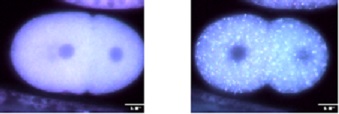Stress granules in a nematode model
Stress induces in cells the formation of aggregates containing proteins and RNAs, called stress granules. As stress granules are associated with some neurodegenerative diseases and cancers, understanding how they form is of great importance.
Stress granule formation has been mainly studied in unicellular organisms and cells in culture. To explore interactions at the scale of an entire organism, researchers from the laboratory of Prof. Monica Gotta use a nematode called Caenorhabditis elegans. This transparent worm is an excellent model for studying stress granules, as the proteins involved in their formation are similar to those in humans.
In their recent study published in the Journal of Cell Science, Simona Abbatemarco and colleagues showed that the key regulators of stress granule formation that were previously identified in human cells are surprisingly not essential to form stress granules in Caenorhabditis elegans. This reinforces the importance of studying biological processes in entire organisms and not only in cell culture.

Embryos of normal Caenorhabditis elegans (left picture) and embryos with stress granules visible as white shiny dots (right picture). © adapted from Figure 1 in Abbatemarco et al. JCS 2021.
22 Nov 2021
